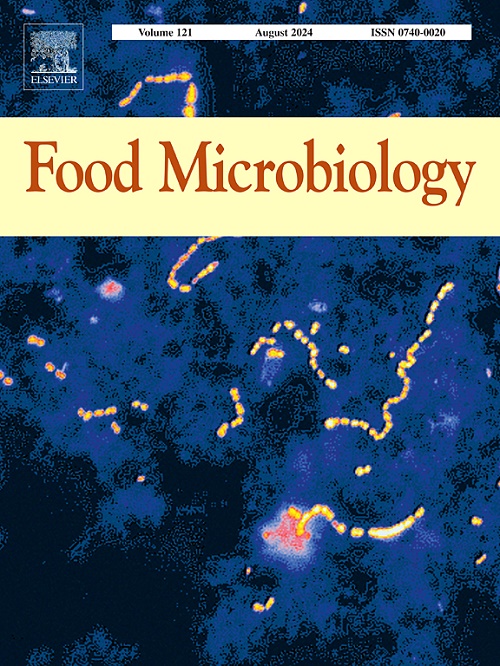采后非生物因子对鼠伤寒沙门菌与生菜叶片相互作用的影响
IF 4.5
1区 农林科学
Q1 BIOTECHNOLOGY & APPLIED MICROBIOLOGY
引用次数: 0
摘要
鼠伤寒沙门氏菌感染的食源性胃肠炎暴发通常与绿叶蔬菜有关。除生物因素外,收获后对蔬菜叶片的附着和粘附以及随后在组织中的存活和内化也受非生物因素介导,主要是光、温度和时间。本研究结合定量培养方法和扫描电镜(SEM)技术,研究了光照(暗= 0 μE m−2s−1和光照= 100 μE m−2s−1)、温度(4℃、12℃和25℃)和储存时间(0 h、24 h、48 h和72 h)对鼠伤寒沙门氏菌UV-BioTag™与污染生菜叶片(Lactuca sativa L. var crispa)相互作用的影响,污染前在测试条件下预处理20 min。2h后,观察到鼠伤寒沙门氏菌对叶片的强烈粘附,在72 h(估计保质期)的储存期间,无论温度和光照条件如何,这种粘附都在增加。扫描电镜显微照片显示,在所有测试条件下,粘附到叶片表面,然后内化到气孔中,形成生物膜样细菌聚集体。该研究强调,即使在没有光线的情况下,沙门氏菌也能够在叶子表面定居。了解非生物因素如何影响这些过程对于制定更有效的策略以尽量减少与食用生叶菜相关的风险至关重要。本文章由计算机程序翻译,如有差异,请以英文原文为准。
Role of post-harvest abiotic factors on interactions of Salmonella typhimurium with lettuce leaves (Lactuca sativa L. var crispa)
Foodborne gastroenteritis outbreaks of Salmonella Typhimurium infections are often associated with leafy vegetables. In addition to biotic factors, attachment and adhesion to the vegetable leaves and subsequent survival and internalization in the tissues in the post-harvest stages are mediated by abiotic factors, mainly light, temperature and time. This study combined quantitative cultural methods and Scanning Electron Microscopy (SEM) to investigate the influence of light (dark = 0 μE m−2s−1 and light = 100 μE m−2s−1), temperature (4 °C, 12 °C and 25 °C) and storage time (0 h, 24 h, 48 h and 72 h) on the interactions of Salmonella Typhimurium UV-BioTag™ with experimentally contaminated lettuce leaves (Lactuca sativa L. var crispa), preconditioned for 20 min in the tested conditions before contamination. After 2h, an intense adhesion of S. Typhimurium to the leaves was observed, increasing during storage for 72 h (estimated shelf life), regardless the temperature and light conditions. SEM microphotographs indicated that the adhesion to the leaf surfaces was followed by internalization into stomata and formation of biofilm-like bacterial aggregates, in all tested conditions. The study highlighted that Salmonella was capable to colonize the leaf surfaces even under the absence of light. Understanding how abiotic factors influence these processes is essential to develop more effective strategies to minimize the risks associated with consumption of raw leafy vegetables.
求助全文
通过发布文献求助,成功后即可免费获取论文全文。
去求助
来源期刊

Food microbiology
工程技术-生物工程与应用微生物
CiteScore
11.30
自引率
3.80%
发文量
179
审稿时长
44 days
期刊介绍:
Food Microbiology publishes original research articles, short communications, review papers, letters, news items and book reviews dealing with all aspects of the microbiology of foods. The editors aim to publish manuscripts of the highest quality which are both relevant and applicable to the broad field covered by the journal. Studies must be novel, have a clear connection to food microbiology, and be of general interest to the international community of food microbiologists. The editors make every effort to ensure rapid and fair reviews, resulting in timely publication of accepted manuscripts.
 求助内容:
求助内容: 应助结果提醒方式:
应助结果提醒方式:


